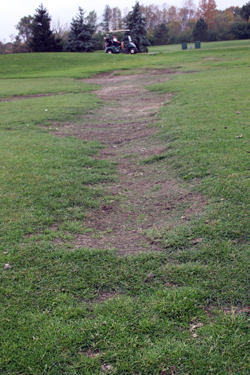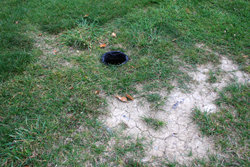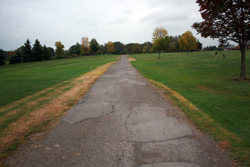Hyde Park Golf Course Was Almost Lost
By Frank Parlato
 |
 |
 |
 |
DPW Director David Kinney acted in the nick of time.
But the City of Niagara Falls' Hyde Park Golf Course was almost lost - or rather immeasurably damaged - because no one applied pesticides all summer.
On September 16, the Niagara Falls Council voted to approve an emergency pesticide contract submitted by Mayor Paul Dyster, but signed by Councilman Charles Walker - as acting mayor.
The $12,250 contract was awarded to Turf USA, a company owned by Charles Calabro of Niagara Falls .
One of the diseases that now infect the Hyde Park Golf Course - and, arguably, it never looked worse than it does today - is the Dollar Spot fungus, which has created huge swaths of straw-colored, sunken spots about the size of a silver dollar on the greens and fairways as it kills the turf.
The course is also threatened by European crane fly larvae which eat the roots, thinning out turf creating large dead patches.
"Basically the city stopped applying fungicide," Calabro, who is a DEC licensed Pesticide Applicator, told the Reporter. "99 percent of the problem is the lack of fungicides. They didn't get these problem in two weeks or two months."
DPW Director Kinney called the need to hire Calabro an "emergency," created, he said, by the fact that the DPW longtime arborist, Paul Dickinson, "suddenly" retired.
Still it was a curious lack of planning. While even modest golf courses have two or more DEC licensed Pesticide Applicators, the Parks Department of Niagara Fall, with their 36 hole golf course, and more than 100 employees, had only one pesticide applicator, Dickinson and he was nearing retirement. No preparation was made for his replacement.
And while Dickinson planned to retire March, 2014, he decided to quit this spring.
According to Calabro, no pesticides were applied since.
"You should be putting down pesticides every month," he said.
Kinney might have gotten any number of his more than 100 workers to apply for a DEC Pesticide Applicators license long ago.
At the time of the council vote to approve the emergency contract, Dyster, although he did not mention it to the council, appointed Walker to be acting mayor to sign the resolution to hand the contract to Calabro.
It turns out Dyster is related by marriage to Calabro.
Calabro is the brother of the husband of the sister of the mayor's wife.
Said another way, Charles Calabro's brother, Anthony, is married to Dyster's wife, Becky's sister Cathi.
In other words, Charles Calabro is the brother-in-law of Dyster's sister-in law.
No big deal.
In fact, Charles Calabro, while he says he admires the mayor, says he is not a personal friend, nor does he attend family gatherings with the mayor.
"I've never been to his house," he said.
So why did the Mayor try to keep it under wraps?
"If you feel it is a conflict, you should publically say it," said former Mayor Vince Anello said. "There might be a family relation there. But I think explaining your action to the public is the right course of action. I don't know why they went in the direction of using an acting mayor to sign it. I don't see why they bothered trying to keep it under wraps."
While Dyster might have wanted his relationship with Calabro kept a secret, Dave Kinney is open about his relationship with Calabro.
Calabro has done lawn care on Kinney's private residence for years.
And Charles's brother, John Calabro, works in the DWP cutting the lawns at the golf course.
Kinney told the Reporter that he did not know the Calabro family was related to the mayor's wife until last week when a Gazette reporter told him.
Dyster told the Gazette he did not know that Calabro had been selected as the contractor for the pesticide work until a request from Kinney arrived on his desk.
Dyster told the Gazette he had Councilman Charles Walker, who is acting mayor in Dyster's absence, sign the resolution to avoid the appearance of a conflict.
"I didn't have anything to do with picking it," Dyster said.
The signature of an acting mayor is not normally used to avoid the appearance of conflict, and certainly not without disclosure.
But Dyster did not reveal what he thought was a conflict until he was asked by the media.
Meantime, what is arguably more important is that Calabro will do five curative treatments. He has already started and will continue until December 10th.
"You had it all year where they neglected it and now we have to cram it down in three months to get it back to normal conditions. They would have never survived if they waited. Once the freeze comes, it's over. They would have lost a good portion of many of the greens, " Calabro said.
The prognosis is good, according to Calabro.
While the lack of planning justified an emergency, which permitted a contract to be handed out without bidding, it was Kinney who contacted Calabro and it appears likely the Golf Course turf by next year will be looking pretty green.